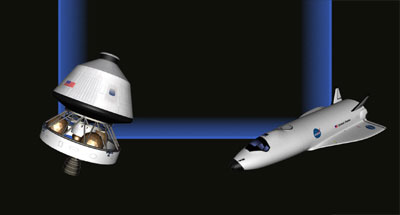Two directions for OSPby Jeff Foust
|
| Post-Columbia urgency has provided momentum for an alternative OSP concept, the capsule. |
These two approaches to OSP—winged vehicle versus capsule—have become the center of debate in the program. The arguments for and against each approach were crystallized in a Capitol Hill forum late last month organized by the House Aerospace Caucus, National Space Society, and Women in Aerospace. The event, which drew a standing room only audience in a House hearing room early on a Monday morning, illustrated the advantages and disadvantages of capsules and winged vehicles.
The case for a capsule
Samuel Durrance, a veteran of two space shuttle missions and current executive director of the Florida Space Research Institute, is a strong advocate of the capsule approach for OSP. “The system architecture requirements argue for a ‘capsule-type’ system,” he said. “One that has a robust abort capability, can land anywhere anytime, and is designed for simplicity.”
Durrance argued that the shape of the OSP is dictated by its flight environment. During launch needs a nose cone or be encapsulated in an aerodynamic payload fairing; it also needs a blunt or flattened bottom for launch aborts. During reentry the vehicle needs a blunt or lifting body shape; wings are desirable only for runway landings. These requirements, Durrance believes, argues more for a capsule approach than for a winged vehicle.
Durrance also advocates looking at the Apollo spacecraft at least as a starting point for a capsule-based OSP design. “The Apollo command module meets the requirements for the CRV,” he said. “The addition of a small service module behind that capsule could provide the crew transfer vehicle support. It could be launched on an Atlas [5] or a Delta [4].”
| “The Apollo command module meets the requirements for the CRV,” Durrance said. “The addition of a small service module behind that capsule could provide the crew transfer vehicle support.” |
Such a system could also take advantage of existing launch and payload processing facilities at Cape Canaveral as a way to reduce costs. “We could establish an assembly line for recovery, refurbishment, integration, and launch,” he said. “We should try to minimize the changes needed in Atlas and Delta launch vehicles for accommodations of crews.”
The Apollo heritage and relatively simple design would allow a capsule OSP to enter service relatively quickly. Durrance said he believes such a vehicle can—and must—be ready by 2007 in order to meet station requirements. While not putting a price tag on the system, he believed that a capsule would also be less expensive to develop than a winged vehicle.
